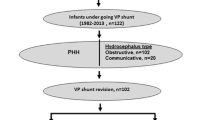Abstract.
Introduction: A retrospective analysis of 42 preterm infants with intraventricular hemorrhage was performed in order to evaluate shunt-related problems in neonates with posthemorrhagic hydrocephalus. Patients and methods: Within the last 15 years, 76 infants with intraventricular hemorrhage were treated primarily by external ventricular drainage, and 42 needed permanent shunting. Shunting was performed 28–101 days after the patients' birth, ventriculoatrial shunts being placed in 10 patients and ventriculoperitoneal shunts in 32. Results: The mean number of shunt revisions per patient was 1.57. The main reasons for shunt revision were infection (7.1%) and blockage (45.2%). Primary ventriculoperitoneal and ventriculoatrial shunts differed only insignificantly in revision rate and length of shunt survival, whereas ventriculoperitoneal shunts used in shunt revisions required significantly fewer further revisions. Conclusions: The neurological outcome was not related to the necessity for or to complications of a shunt. Programmable valve systems and neuroendoscopy appear to be helpful in the overall management and in the treatment of complications.
Similar content being viewed by others
Author information
Authors and Affiliations
Additional information
Electronic Publication
Rights and permissions
About this article
Cite this article
Reinprecht, A., Dietrich, W., Berger, A. et al. Posthemorrhagic hydrocephalus in preterm infants: long-term follow-up and shunt-related complications. Child's Nerv Syst 17, 663–669 (2001). https://doi.org/10.1007/s00381-001-0519-2
Received:
Revised:
Published:
Issue Date:
DOI: https://doi.org/10.1007/s00381-001-0519-2




